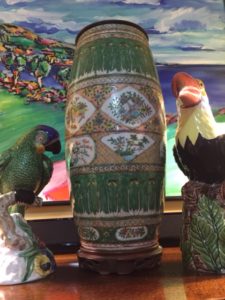 JS sent me a beautiful 18 inch canister shaped Chinese vase. She wonders why it bears a design with a repeating ‘grasses’ theme, and how old is it? She brings up a profound element of Chinese porcelain design: the symbolism of the objects, animals, plants, birds, and vegetation pictured. Why? This tradition of symbolism goes back way before the Ming Dynasty (1368-1644). But JS, the green stuff is not grass, the repeating design depicts CABBAGE.
JS sent me a beautiful 18 inch canister shaped Chinese vase. She wonders why it bears a design with a repeating ‘grasses’ theme, and how old is it? She brings up a profound element of Chinese porcelain design: the symbolism of the objects, animals, plants, birds, and vegetation pictured. Why? This tradition of symbolism goes back way before the Ming Dynasty (1368-1644). But JS, the green stuff is not grass, the repeating design depicts CABBAGE.
Cabbage, you say? What deep symbolism might the connoisseur of Chinese porcelain have found in CABBAGE?
Chinese cabbage is white in the stalk and spreads to a delightful delicate rich green, and when harvested, contains insects sequestered in its tight leaves. The cabbage symbolizes female purity, the white stalk, which spreads to green abundance and fertility. If you look at the picture of JS’s vase, you see the cabbage harbors beautiful little butterflies or yellow moths, which repeat. I love how a simple vegetable takes on such dimensions. The Chinese cabbage shows us the global domination of a Chinese vegetable.
We find the cabbage’s medicinal qualities written about as early as the 14th century. Planted in places typically too cold for vegetable life, and therefore ‘suan cai’ (Chinese sauerkraut to mix heritages) became a staple.
Butterfly Symbolism
We also see the butterfly or moth, which ALSO repeats around the cabbage design of the vase. This exemplifies the Chinese porcelain-painter’s interweaving of the NAME of a thing and the IMAGE of a thing. The word that sounds like butterfly also means “to repeat.” So although we usually think of a homophone as two WORDS that sound the same yet are spelled differently (KNEW AND NEW). In this case the Image of a butterfly conjures up the WORD for repeat. Why is this important?
Butterflies symbolizes the search for love found! So, to repeat the image, and saying to yourself the word, REPEATS the blessings conferred by the symbol of a butterfly.
Now we mix the butterfly symbolism with the cabbage symbolism, and what do we get? Cabbage is also an audio-visual homophone. The word for cabbage ‘bai cai’ contains the word ‘cai’ which means wealth and money. Now who doesn’t want to give someone a piece of art that says in symbolism: I wish you wealth, and well-found love?
Let us add to this that the vase also pictures birds. The bird is also multiplied symbolically because the bird represents one of the five elements of nature. Each element has a compass direction as well. The five classes of animals are scaled, naked, furry, feathered, and shelled. Birds symbolize the SOUTH direction of the compass. You might think of only four compass points, and also remains true in Chinese symbolism. However, the compass also contains a MIDDLE, and the naked animal occupies that MIDDLE. Who is the naked animal? Why, WE are? We are the only naked animal, us humans, and we stand at the center of the compass.
DEEP Reading of a Chinese Vase
The connoisseur in the 19th century who ordered this made in China knew every INCH of the symbolism involved. They read it like a book.
Finally, JS asks, how OLD it is? It is a type of hard paste porcelain made in the early 19th century, and still flourished in the late 19th century called Chinese Export Porcelain. Europeans didn’t know how to MAKE porcelain until the late 18th century. Even in the 19th century the recipe remained expensive and inaccurate in Europe. So, from the port of Canton in China exporters sent TONS of porcelain as ballast in ships to European ports, and the upper class bought the pieces hungrily.
This is a type of Chinese Export called Famille Verte, which is the green family, and there’s also classes of rose, yellow, etc. JS’s vase has been repaired which is not uncommon and actually points to the value it must have had in former eyes. The foot is unglazed as the case with most real export porcelain. I began my career with Chinese Export Porcelain, and still own a piece repaired with a metal STAPLE.
The value of JS’s vase is $800.